Moroni That Might Have Been
Mesa Arizona
Salt Lake had the first statue in 1892 of course, and Los Angeles had the second in 1954. But things could have been a bit different. [1]Paul L. Anderson, “Desert Imagery and Sacred Symbolism: The Design of the Arizona Temple,” Journal of Mormon History, vol. 31, no. 1, 2005, pp. 71–98. JSTOR, www.jstor.org/stable/23289248. Accessed 26 Nov. 2020.
During the design period of the Mesa Arizona temple back in the early 1920s, the Church requested designs from multiple architects. One of those architects, Pope and Burton, submitted an entry that had an Angel Statue similar to the One on Salt Lake. Pope and Burton had already designed the Laie Hawaii and Cardston Alberta Temples. Their submission for Mesa was more ornate than the other two designs, with detailed window ornamentation, and a short central tower topped with a trumpeted statue.
Pope and Burton were not the only ones with such ideas. Young and Hansen, the team who would create the winning design for Mesa Arizona, went through several design ideas and studies. for the temple before settling on the final submission. Amongst these design ideas where two that look like they might have been intended to have the statue, and one that absolutely did have the statue.
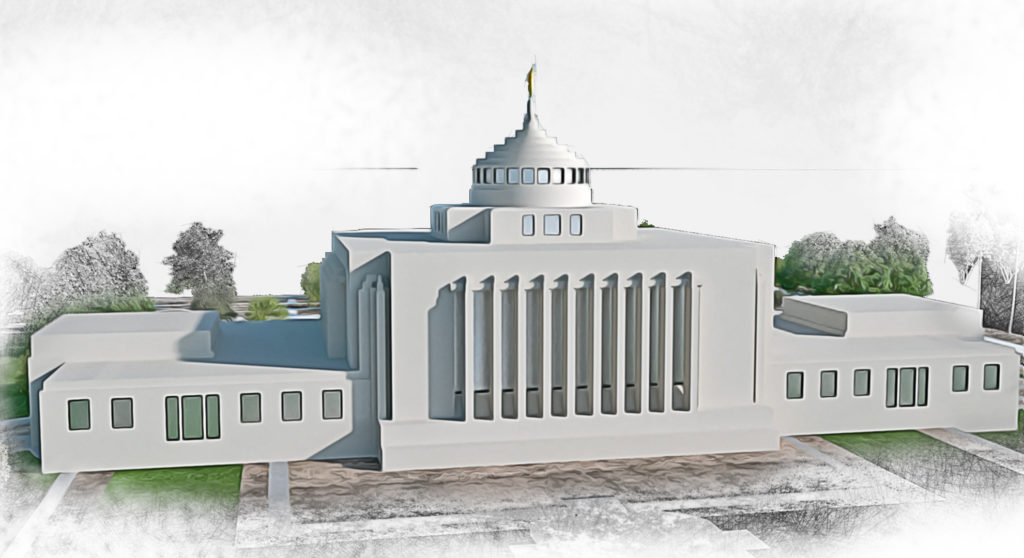
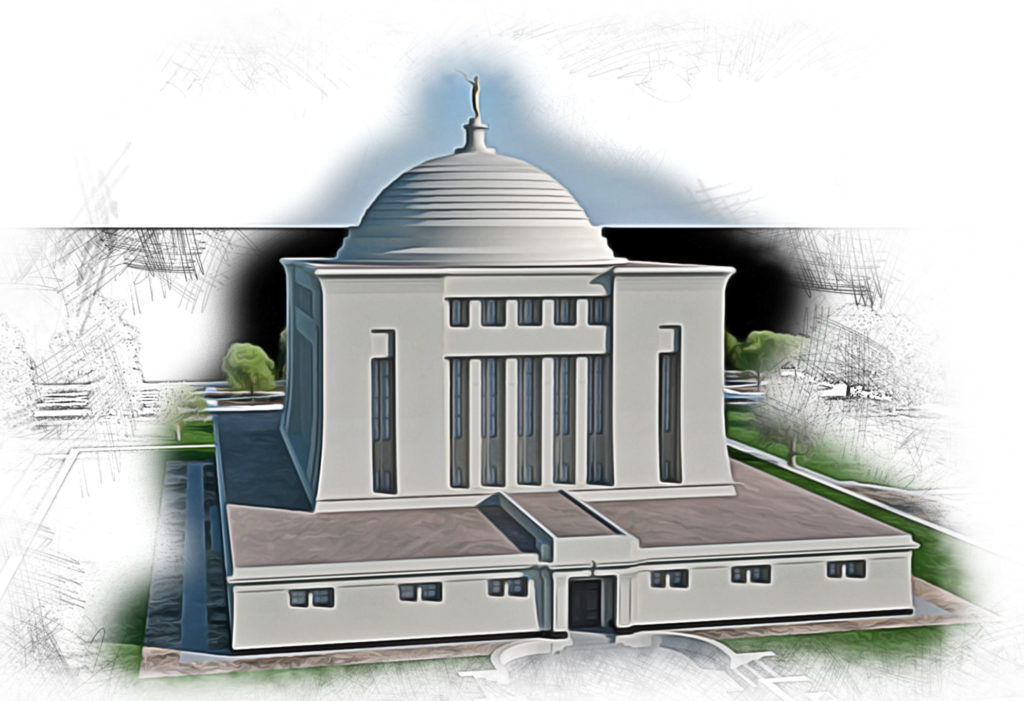
At this point in time, there were only six other temples in the world, and of those six, only Salt Lake had an angel statue, so, design wise, the suggestion to include a statue was quite the departure from the normal.
This temple, like Salt Lake and the future Los Angeles Temple, would have been built prior to the days when large scale fabrication would allow statues to be cast over and over again. So, it is most likely that this statue would have needed to be one-time unique creation had the Church chosen to use the statue topped idea.
Provo and Ogden
The construction of the Ogden and Provo Temples brought several new ideas to the practice of building temples. Reusing a floorplan but changing the exterior (something the Church now does frequently.) High efficiency layouts allow more people to use a temple in a single day than ever before. An economy in construction and materials that would allow the Church to construct multiple temples across the world.
The design process for these two temples would once again bring attention back to Angel Moroni Statues. One early render for Ogden, and two early renders for Provo show the angel Moroni perched atop the narrow spire. This would have been no small feat as the only two statues placed at that point weighed thousands of pounds and required thick, bulky spires to support the weight.
However, even then, the use of a Fiberglas statue at the World’s Fair “Mormon Pavilion” in New York hinted at alternative methods that might allow for the spire to have a statue. For cost and economy reasons the Angels were eliminated from the design, and the next generation of temples would look into eliminating the spire as well.
Ogden was temple 14, and Provo was number 15. Of the 13 other temples in the world, only two, Salt Lake, and Los Angeles had statues. The suggestion to include them would, once again, indicate a departure from normal practice.
Like the Mesa Temple design, these temples were built before the Church had the ability to mass produce Angel Moroni Statues, so it can only be assumed that unique statues would need to have been made for each temple, or for this pair of temples alone.
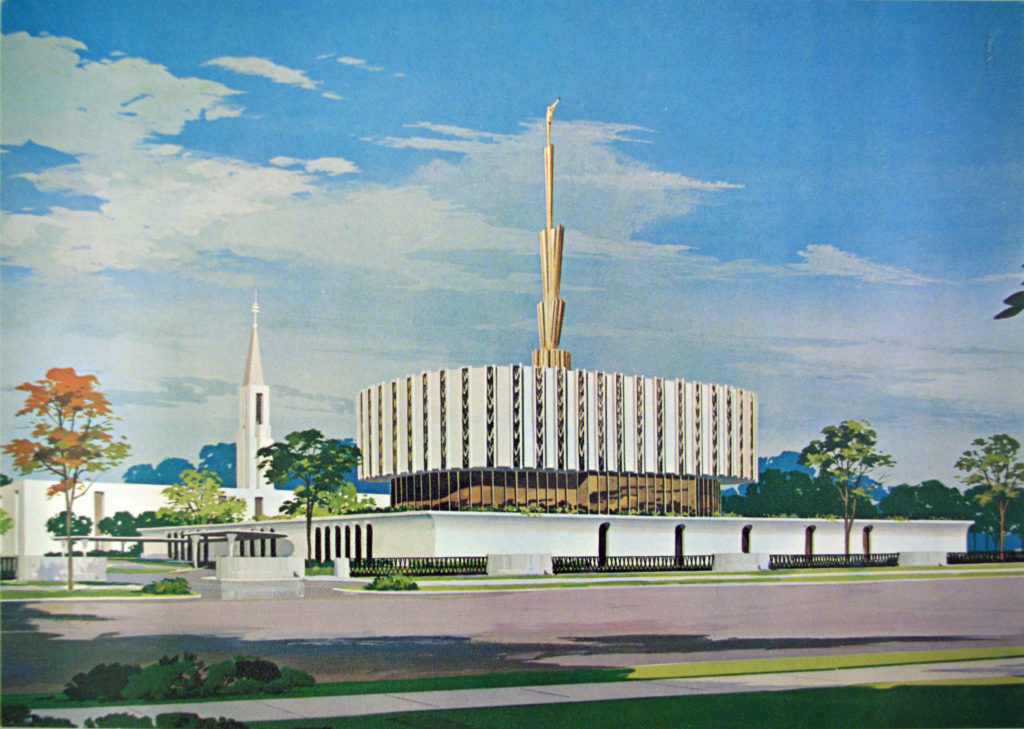
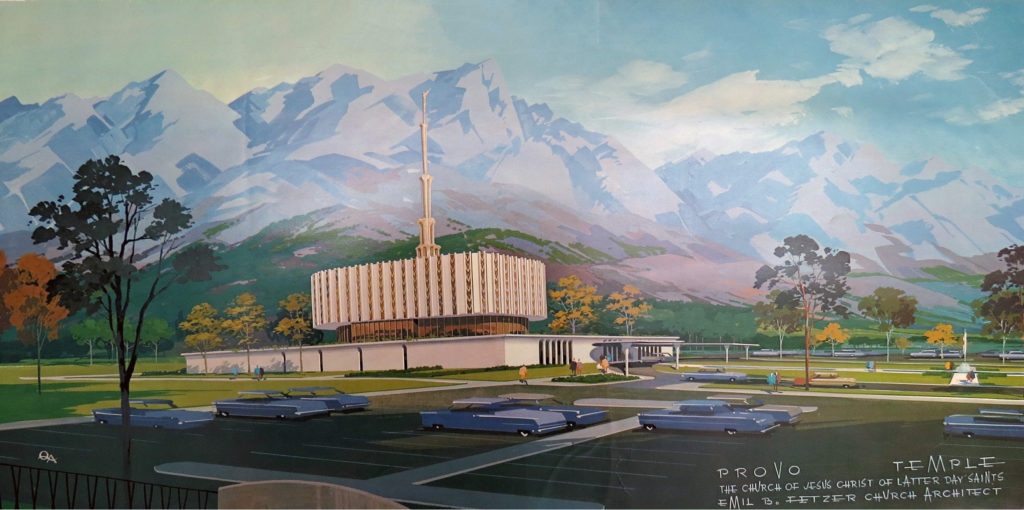
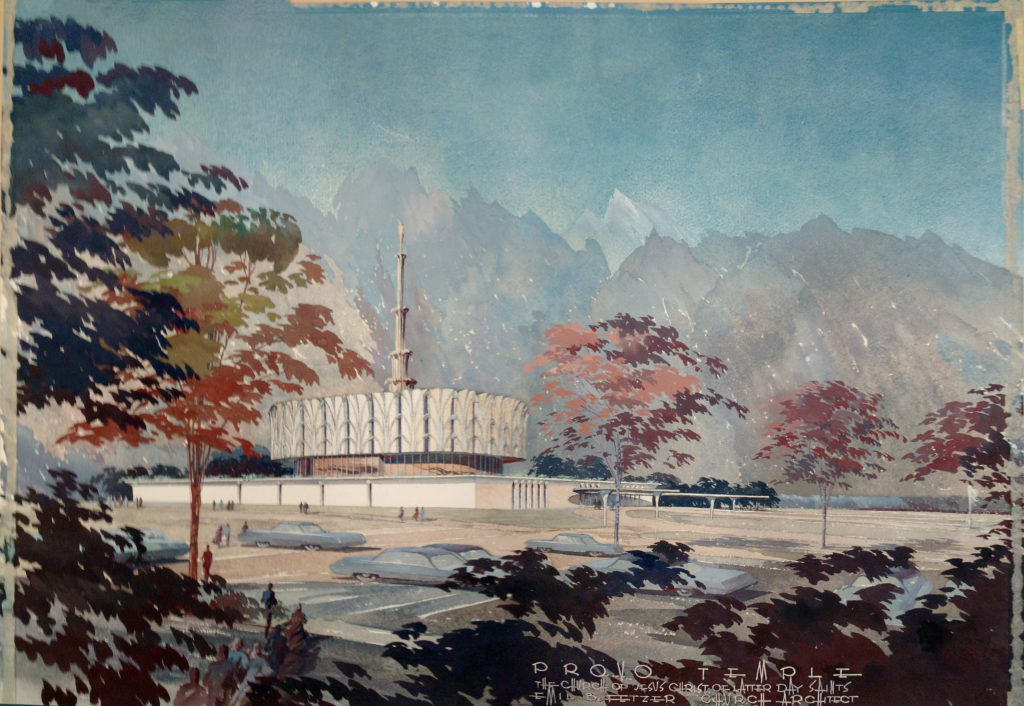
Washington D.C.
During planning for the Washington D.C. Temple, the church invited prominent LDS sculptors to submit designs for the Angel Moroni that would top the east center spire.[2]“Angel Moroni Statue Chosen for Temple” Church News, 10 July 1971.
One source states that nine sculptors submitted statuettes for consideration. A different article in the 10 July 1971 issue of the Church News states that there were eight statuettes submitted by prominent sculptors. However, to date, 9 statues have been identified as having been submitted for consideration.
As far as I have been able to identify, this is a unique situation. With other statues, both before and after, the Church has chosen one sculptor and approached them with the commission for the Angel Moroni.
Of the eight statues submitted, the Church settled upon the statue submitted by Avard Fairbanks. Aside from Avard Fairbanks, statues were also submitted by
- Dallas J. Anderson
- Justin F. Fairbanks (Avard Fairbanks son)
- Edward J. Fraughton
- Franz M. Johansen
- J. Dell Morris
- Dennis V. Smith
- Karl A. Quilter (would later sculpt 3 additional statues)
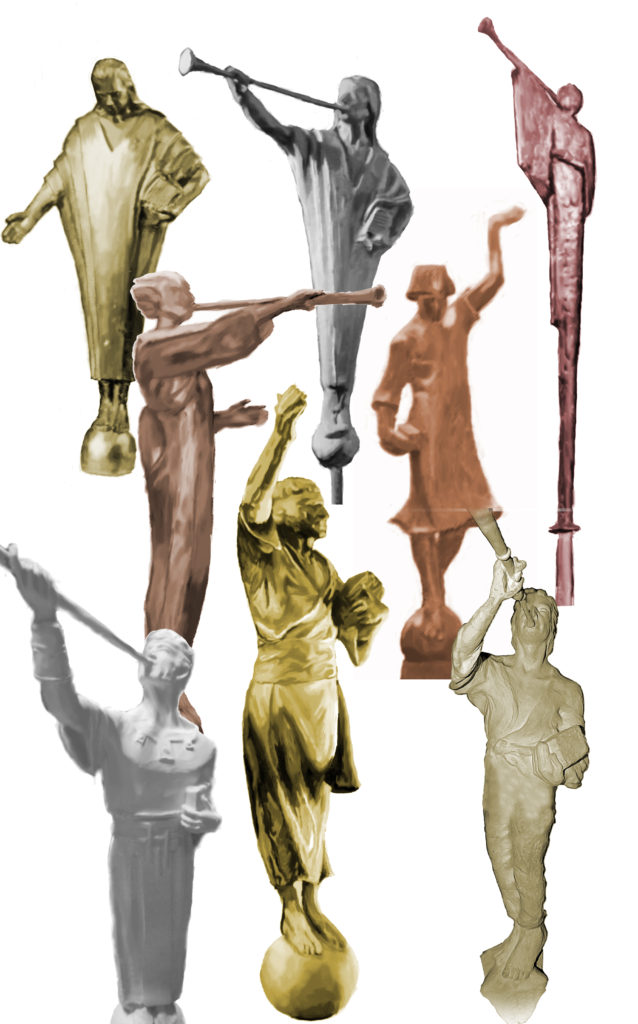
Nauvoo Illinois
On 4 April 1999 during the closing session of General Conference, President Hinckley announced that the Historic Nauvoo Temple would be rebuilt to match the 1846 appearance, with some minor changes. One of those minor changes, turned out to be at the top of the dome on the stately tower.
The original tower was topped with a weather vane in the shape of an angel. This angel, rather than being a flat cutout of an angel has been described as “a finely produced three-dimensional shape appearing almost humanlike”.
When it came to decide on what to place on the top of the reconstructed temple, the Church approached Karl Quilter for design proposals. One of the designs was a multidimensional shape, representing as closely as possible the original Nauvoo weather vane.[3]According to information provided by Marvin Quist, original source unknown
Another design he presented, was another 3-dimensional weathervane. It was in a run-like pose, appears to be flying, and is more reminiscent of the scripture in the book of Revelation than the full upright angel we typically see.[4]Rosner, Jannalee. “‘Super Moroni’ Statue Almost Appeared on Nauvoo Temple, Sculptor’s Son Recalls.” LDS Living, 27 Oct. 2016, While more similar to Quilters other statues, it was still rather unique.
In the end, the design that President Hinckley decided upon was a new standing statue, like Brother Quilters other statues. At President Hinckley’s request, the left hand of the statue was made to be open. This open hand lands an additional sense of motion to the statue. It has been reported far and wide, online and in print that this statue is a larger scale version of a small statuette that Brother Quilter originally sculpted for his grandchildren as a gift to be presented when they finished reading the scriptures. This is not the case, as that particular statue is closer in design to Brother Quilter’s 10-foot statue than it is to the Nauvoo Temple.
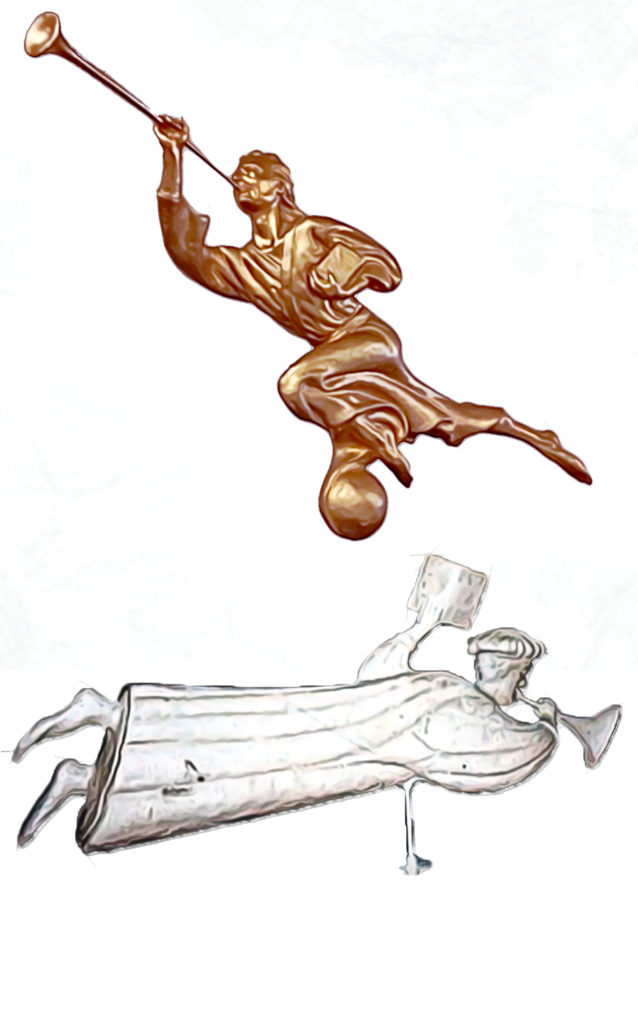
Chapter 5 Navigation
References
| ↑1 | Paul L. Anderson, “Desert Imagery and Sacred Symbolism: The Design of the Arizona Temple,” Journal of Mormon History, vol. 31, no. 1, 2005, pp. 71–98. JSTOR, www.jstor.org/stable/23289248. Accessed 26 Nov. 2020. |
|---|---|
| ↑2 | “Angel Moroni Statue Chosen for Temple” Church News, 10 July 1971. |
| ↑3 | According to information provided by Marvin Quist, original source unknown |
| ↑4 | Rosner, Jannalee. “‘Super Moroni’ Statue Almost Appeared on Nauvoo Temple, Sculptor’s Son Recalls.” LDS Living, 27 Oct. 2016, |
